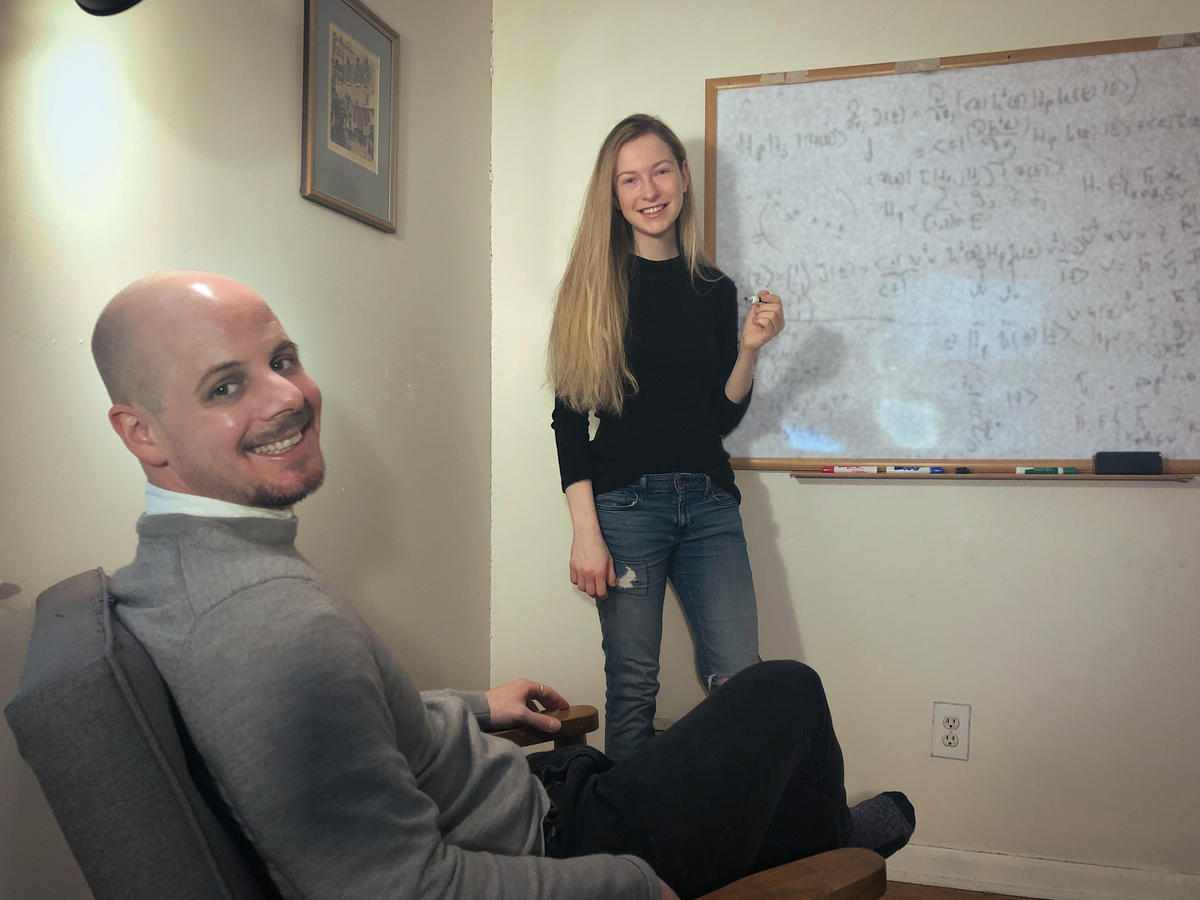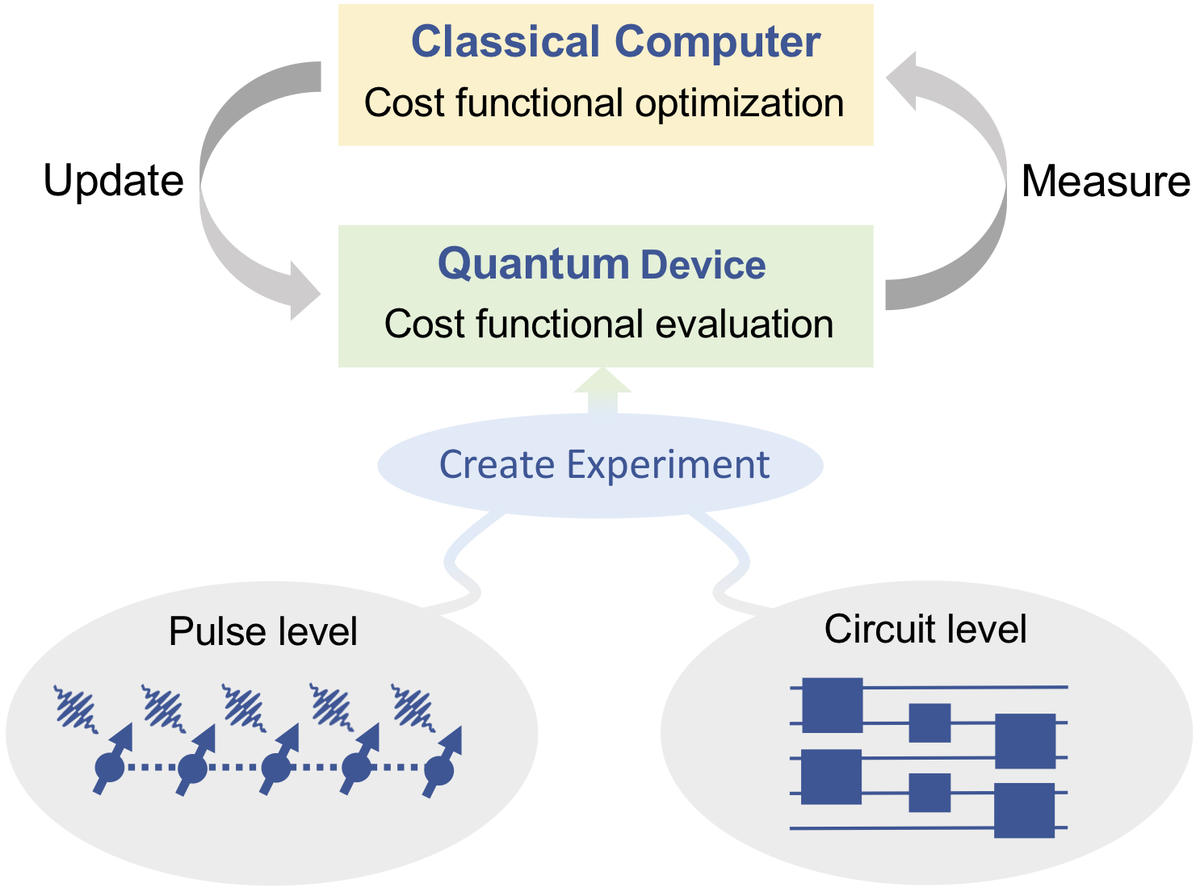Rabitz group links control and Variational Quantum Algorithms
There are many steps on the road to scientific advance, an axiom that is especially true for quantum technologies. Although progress over the past decade has put quantum computing firmly on the horizon, large scale, fault-tolerant quantum computing devices are currently just that – on the horizon.
In the meantime, scientists have built noisy intermediate-scale quantum (NISQ) devices that lie somewhere along that continuum. In order to probe the capabilities of these devices, a promising option is to use them to run a type of machine that straddles both the quantum and digital worlds, called a Variational Quantum Algorithm (VQA). Some of the prime applications under study for VQAs are directly relevant to chemistry, such as facilitating better ways to calculate the energy of molecules.

Photo courtesy of Alicia Magann
A team of researchers in the Department of Chemistry’s Rabitz Group has published a perspective that deepens this promise by looking at the use of VQAs through the lens of quantum optimal control. They present important connections between quantum optimal control and VQAs starting from the realization that both rely on classical and quantum resources working in tandem.
“We can borrow many of the tools from known optimal control theory for this new frontier, VQAs” said Tak-San Ho, a research scholar with the group who has decades of experience in quantum control theory. “We saw a clear relationship that may be relevant for improving the performance of these nascent VQA quantum devices.”
He added that the demonstrated relationship is fundamental and will need to be translated into operational practice.
The group’s perspective, “From pulses to circuits and back again: A quantum optimal control perspective on variational quantum algorithms,” was published this week in PRX Quantum, a new on-line journal of the American Physical Society.
One of the key challenges surrounding NISQ devices is the problem of noise, broadly defined as disturbances that can be present in a myriad of forms. NISQ devices are fragile and extremely sensitive to noise, which can degrade their computational capabilities, thereby negating any potential advantage they may have over conventional computing.
“How a quantum computer works in theory is very well understood. But in practice, a key challenge is to deal with the noise that is present, how it enters, and how to mitigate it,” said Christian Arenz, an associate research scholar with the Rabitz Group and a department lecturer.
“The bottom line is, you need to be able to control the processes at play in quantum devices. So this perspective points out that the efficiency and performance of the VQAs depends also on how well the quantum system can be controlled,” said Arenz. “That’s where we want to push: not just to improve the quality of the system components, but also to better control the NISQ relevant quantum processes.”
“Shared Framework”
Alicia Magann, a fifth-year graduate student in the group, said the perspective proposes a shared framework between quantum optimal control and VQAs, which will allow researchers to port theory and results over from the former to promote the facility of the latter.
Just as scientists discover effective laser fields in quantum control experiments, the Rabitz Group proposes that the usefulness of VQAs can be tapped through the same process of measurement, refinement, and iteration.

Figure courtesy of the Rabitz Group
“The goal of a VQA is to find a solution to a problem by using both a quantum computer and a conventional classical one, working together,” said Magann. “So, we run a computation on a quantum computer that depends on some parameters and then quantify how well this computation solves our problem by doing measurements on the quantum computer. We then use a classical computer to refine the parameters, and then just iterate back and forth between the quantum and classical computers until we have reached a sufficiently good solution.
“Importantly, this is the same iterative strategy that has been used in quantum control experiments, like the ones here in the Rabitz Group laser laboratory,” she explained, “where we apply a laser field to a quantum system, use measurements to quantify how well it achieved our control goal, update the field, update it again, until finally we arrive at a laser field that achieves the controlled behavior that we want in our quantum system.
“There’s still a lot of work to be done,” she said, “but the hope is that this shared framework will help to facilitate progress. A huge toolbox from quantum control theory has been developed over the years, here at Princeton and elsewhere, which we hope can inspire new developments in VQAs to advance quantum information science.”
Roughly a year ago, Herschel Rabitz, Princeton’s Charles Phelps Smyth ’16 *17 Professor of Chemistry, met Google scientist Jarrod McClean at a conference. They realized their presentations had focused on the same general problem, with McClean lecturing from the perspective of VQAs and Rabitz lecturing from the perspective of quantum control.
McClean is a co-author on the Rabitz perspective.
“The operation of VQAs and quantum computers draws on the principles of quantum control,” said Rabitz. “But the quantum information community largely split off from the quantum control community around 2000, and the two have become farther and farther removed from each other.
“We thought it would be a good thing to bring them back together through the perspective article.”
The perspective is the product of collaboration with several groups, including Sandia National Laboratories in Livermore, CA; SC Solutions in Sunnyvale, CA; and Google Research in Venice, CA.
Read the full journal Perspective here:
https://journals.aps.org/prxquantum/abstract/10.1103/PRXQuantum.2.010101
“From pulses to circuits and back again: A quantum optimal control perspective on variational quantum algorithms,” was authored by Alicia B. Magann, Christian Arenz, Matthew D. Grace, Tak-San Ho, Robert L. Kosut, Jarrod R. McClean, Herschel A. Rabitz, and Mohan Sarovar. Magann was supported in this work by the U.S. Department of Energy, Office of Science, Office of Advanced Scientific Computing Research, under the Quantum Computing Application Teams program; and by a U.S. Department of Energy Computational Science Graduate Fellowship, grant number DE-FG02-97ER25308. Arenz was supported by the U.S. Army Research Office, grant number W911NF-16-1-0014. Ho acknowledges support from the U.S. Department of Energy, grant number DE-FG02- 02ER15344.
